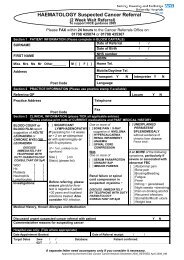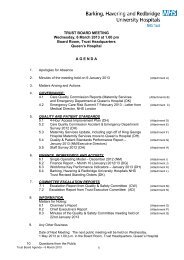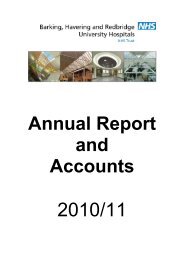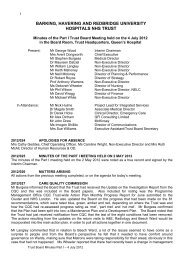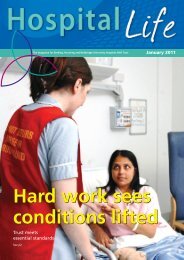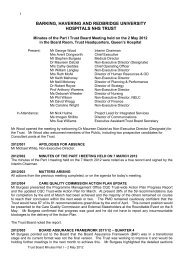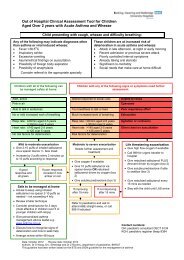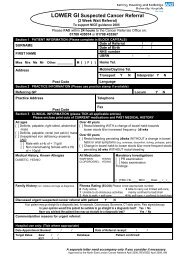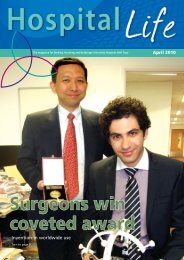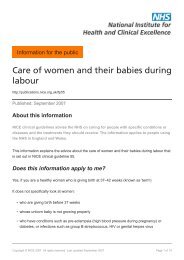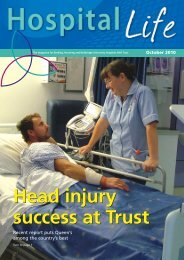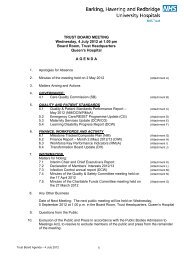Biochemistry Newsletter issue 5 - Barking Havering and Redbridge ...
Biochemistry Newsletter issue 5 - Barking Havering and Redbridge ...
Biochemistry Newsletter issue 5 - Barking Havering and Redbridge ...
Create successful ePaper yourself
Turn your PDF publications into a flip-book with our unique Google optimized e-Paper software.
BHRUT BioNews<br />
April 2011 Volume 2, Number 1<br />
In This Issue<br />
• Information available<br />
via our website<br />
• Food Allergy – a<br />
NICE place to start<br />
• User feedback<br />
• Books of Interest:<br />
Primary Care <strong>and</strong><br />
Laboratory Medicine<br />
• New tests in the<br />
literature:<br />
cardiotrophin-1<br />
Welcome<br />
Welcome to the First <strong>issue</strong> of BioNews in 2011, a newsletter from the<br />
Department of Clinical <strong>Biochemistry</strong> at BHRUT. In this <strong>issue</strong> we have a report<br />
on the new NICE Clinical Guideline 116, “Food Allergy diagnosis <strong>and</strong><br />
assessment of food allergy in children <strong>and</strong> young people in primary care <strong>and</strong><br />
community settings” (CG116) by Dr<br />
Matthew Buckl<strong>and</strong>, Consultant Immunologist Barts <strong>and</strong> the London NHS Trust.<br />
The full guideline <strong>and</strong> the quick reference guide are available on the NICE<br />
website (or can be accessed directly via this link<br />
http://guidance.nice.org.uk/CG116).<br />
As a way of introduction to our team – each <strong>issue</strong> includes a short cameo of<br />
one of our staff – so that you can get to know us a little better. See below<br />
Funmi Akinlade, Principal Clinical Biochemist, Queen’s Hospital. You can<br />
view previous <strong>issue</strong>s of our newsletter via the website.<br />
Contact Us<br />
biochemistry@bhrhospi<br />
tals.nhs.uk<br />
Please note that the<br />
<strong>Biochemistry</strong> email<br />
address should only<br />
be used for general<br />
enquiries.<br />
Food Allergy – A NICE place to start<br />
The first NICE guidance on allergy testing has been recently published. When<br />
thinking where NICE might start, food allergy in children <strong>and</strong> young people was<br />
perhaps not the obvious choice. It would have been simpler perhaps to think<br />
about guidance on managing seasonal allergic disorder. Credit where it’s due,<br />
tackling a tough problem head on makes the next hurdle easier. The positive<br />
part of this will be raising awareness of allergy as a clinical problem <strong>and</strong> a<br />
rational approach to testing <strong>and</strong> treatment paradigms. The difficult part will be<br />
that allergy testing by laboratory methods (i.e. specific IgE testing) is likely to<br />
increase <strong>and</strong> that there will be no increase in funds allocated to the laboratory<br />
to accommodate this at a time of great financial pressure.<br />
The NICE guidance states that clinicians should think about testing more by<br />
skin prick testing or specific IgE when you have a patient with a history of an<br />
IgE mediated reaction. Since very few people in community based practice use<br />
skin prick testing, this will largely be specific IgE testing. So here I would like<br />
to introduce a word of caution that we should introduce careful targeted testing<br />
to those things that the patient is clear that they have a history of reactions to,<br />
because the NICE guidance does move on quite quickly from history to testing,<br />
without exploring in too much detail the causality step in the history <strong>and</strong> for<br />
food allergy the devil is in the detail. Non-IgE mediated reactions need to be<br />
carefully delineated from IgE mediated reactions. Urticaria or angioedema are<br />
common <strong>and</strong> are frequently not causally related to food, but may be<br />
temporally related because we all eat so often! A positive test, be it a skin<br />
prick test or specific IgE tells you that someone is sensitized, <strong>and</strong> therefore<br />
potentially atopic, but not that they are allergic to something, only the history<br />
can tell you that. Equally a negative test may need confirmation with a<br />
diagnostic challenge in an appropriate clinical environment if there was a
If you have any<br />
suggestions for the<br />
next <strong>issue</strong> please<br />
contact the Editing<br />
team<br />
If you would like to<br />
receive this e-<br />
newsletter please<br />
send your email<br />
address to us at<br />
<strong>Biochemistry</strong>@bhrhos<br />
pitals.nhs.uk<br />
compelling history <strong>and</strong> in the case of food allergy this should be done by<br />
appropriately qualified individuals.<br />
The purpose of the test should be to focus the further clinical management as<br />
with all tests. If the result of the test is not going to modify management then<br />
should it be done This is especially true with specific IgE testing where<br />
evidence of multiple sensitization is often found <strong>and</strong> patients rapidly end up on<br />
very restrictive diets, even though they are not allergic to many of the<br />
components.<br />
I think the guidance may be very useful as a source of discussion <strong>and</strong> debate,<br />
but would like to caution against an increase in additional “allergy testing” but<br />
perhaps better tools for allergy histories.<br />
User Feedback<br />
Many thanks for those that completed the feedback questionnaires sent out in<br />
Dec.2010. Your evaluation <strong>and</strong> comments have been noted <strong>and</strong> will in part<br />
form part of our planning for 2011.<br />
We were quite pleased to find the high overall level of satisfaction of our<br />
services. Below is a summary of our responses to your comments:<br />
1. For clinical advice on the interpretation of results or advice on further<br />
investigations you can contact the Duty Biochemist:<br />
Queen’s Hospital 01708 435 000 ext. 6194<br />
King George Hospital 0208 970 8021/8023<br />
2. To obtain laboratory results for <strong>Biochemistry</strong> or Haematology please use the<br />
following numbers:<br />
Queen’s Hospital 01708 435 422<br />
King George Hospital 0208 970 8021/8023<br />
3. The Bio e-newsletter will continue to be used as medium to get information<br />
out to our users.<br />
4. <strong>Biochemistry</strong> staff are keen to attend GP teaching sessions to assist in the<br />
appropriate use of our services <strong>and</strong> interpretation of results. If you would like<br />
to arrange a session please contact us either by email:<br />
biochemistry@bhrhospitals.nhs.uk or on one of the numbers above.<br />
5. Please note that when a test such as thyroid function tests or HbA1c is not<br />
performed because it is too close to a previous request we currently report the<br />
previous result/s on that report. If you encounter instances where the previous<br />
result has not been provided please contact us with the details as it may well<br />
be an IT <strong>issue</strong>. If you would like to receive the full report of the user feedback<br />
please contact us <strong>and</strong> this can be sent to you.<br />
Requests for Vitamin D<br />
There have been a number of surgeries sending in non-st<strong>and</strong>ard request forms upon<br />
which Vitamin D is printed as an integral part of the bone profile tick box. Please<br />
note Vitamin D is not part of a routine bone profile <strong>and</strong> must be requested<br />
separately with a valid reason for the test. Vitamin D will NOT be processed if<br />
seen to be within the Bone profile tick box.
Books of Interest: Primary Care <strong>and</strong> Laboratory<br />
Medicine<br />
ACB Venture book Primary Care Lab Medicine,<br />
Frequently asked questions. Stuart Smellie, Cliodna<br />
Mcnulty <strong>and</strong> Mike Galloway. ISBN 978-0-902429-<br />
46-8.<br />
Primary care is an area where collaboration <strong>and</strong> cooperation<br />
is required between general practitioners <strong>and</strong><br />
laboratory staff in order to achieve effective use of<br />
resources. This text aims to bridge the gap between<br />
general practice <strong>and</strong> the laboratory by providing a<br />
single reference text in an easy-to-use format. The first<br />
three chapters of the book concentrate on the<br />
relationship between the GP <strong>and</strong> the laboratory, with<br />
discussion on the position of primary care within the health service, the workload<br />
in general practice, the provision of a laboratory service <strong>and</strong> the interpretation of<br />
laboratory data. The four subsequent chapters discuss each of the four main<br />
laboratory disciplines in detail: clinical biochemistry; haematology;<br />
histopathology/cytology; <strong>and</strong> microbiology. Particular emphasis is on presentation<br />
<strong>and</strong> laboratory investigation of common clinical conditions.<br />
This book sets out to consider a wide range of the questions that are frequently<br />
asked of laboratory medicine specialists by primary care practitioners. It is<br />
intended as a guide for doctors, nurses, those in training, <strong>and</strong> perhaps also the<br />
laboratory specialist who is looking for brief guidance on unfamiliar topics. In<br />
many cases the questions have no single right answer, but what is offered is a<br />
review of the guidance available nationally <strong>and</strong> internationally to seek to offer ‘the<br />
best answer we can’.<br />
http://www.acbstore.org.uk/site/product.aspxproductuid=255445&ClickProductO<br />
nPage=/site/index.aspx<br />
New tests in the literature<br />
Monserrat et al. (2010) Cardiotrophin-1 plasma levels are associated with the<br />
severity of hypertrophy in hypertrophic cardiomyopathy Eur Heart J (2011)<br />
32 (2): 177-183. doi: 10.1093/eurheartj/ehq400<br />
Cardiotrophin-1 (CT1) is part of the IL-6 cytokine family <strong>and</strong> has been shown to<br />
induce cardiomyocyte growth <strong>and</strong> survival <strong>and</strong> thus promoting structural changes<br />
in the myocardium. CT1 is secreted by the coronary sinus into the peripheral<br />
circulation. Levels of CT1 have been found to be elevated <strong>and</strong> correlated with the<br />
severity of heart disease in patients with left ventricular failure typical of cardiac<br />
diseases such as hypertensive heart disease, aortic stenosis, coronary aortic disease<br />
<strong>and</strong> dilated cardiomyopathy. The study above investigated CT-1 concentrations in<br />
patients with Hypertrophic cardiomyopathy (HCM), a genetic condition<br />
characterized by the development of left ventricular hypertrophy (LVH) in the<br />
absence of hypertension <strong>and</strong> valve disease. CT1 concentrations were found to be
significantly (p
Cyberlab results<br />
When requesting tests please note that where no hospital or NHS number is<br />
recorded on the requests for then it is likely that the results will not go into<br />
Cyberlab <strong>and</strong> you will be unable to access results electronically.<br />
Access to information on our website<br />
Please note that we are improving the information on the BHRUT website to<br />
make information more widely available. Currently the following is available on<br />
the website:<br />
• Pathology User Guide<br />
• Allergy Testing User Guide <strong>and</strong> Request form<br />
• Previous <strong>issue</strong>s of BioNews<br />
• Reference Ranges<br />
• Referral Laboratories used by the <strong>Biochemistry</strong> Department<br />
Access it directly from here:<br />
http://www.bhrhospitals.nhs.uk/gp/gpbiochemistry.php<br />
A dedicated Pathology microsite is coming soon. This will contain more user<br />
friendly versions of the above documents <strong>and</strong> much more.



![[4] Biopsy Leaflet.pub - Barking, Havering and Redbridge University ...](https://img.yumpu.com/51285530/1/190x134/4-biopsy-leafletpub-barking-havering-and-redbridge-university-.jpg?quality=85)

